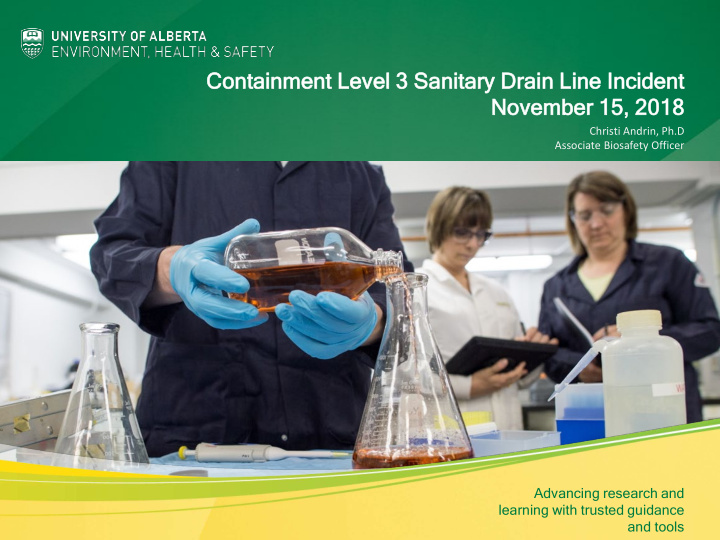



Cont ontai ainmen ent Lev Level el 3 3 Sani anitary Drai ain n Li Line ne Inc ncident Nov ovember 15, 15, 2018 2018 Christi Andrin, Ph.D Associate Biosafety Officer Advancing research and learning with trusted guidance and tools
CL-3 Sanitary Drain Line Incident I. Summary of Incident II. Investigation Findings a. Causal Factors b. Root Cause III. Corrective Actions a. Development of unique monitoring system IV. Lessons Learned Overvi rview
November 15 th . . . within the infrastructure support area for the CL3 F&O Millwrights discover water on floor and pouring from the ceiling 1 Plumbers verify with Biosafety that it is safe to enter Water leaked on equipment, 2 ventilation systems, electrical control panels Incident ent S Summar ary
Hydroclave holding tanks found 3 FULL with water backing up through the drainage system Incident ent S Summar ary
Weight of water caused the 4 several joints on the drain line to fail; some lines broke Source of water was NOT clear • No water running or leaking fixtures within CL3 facility • No alarms on the autoclaves or indications of concern Incident ent S Summar ary
November 16 th . . . CL3 Autoclave identified as source of the water Air valve controlling the cooling water valve FAILED on one autoclave • very rare type of failure • water valve forced open • domestic cold water running continuously at building pressure Inves estigat ation on
INFRASTRUCTURE/EQUIPMENT • Integrity of drainage system – improper installation, inadequate supports joint not seated properly • Autoclave valve failure - no feedback to autoclave systems regarding the failed valve(s) Caus ausal F Fac actors
• Hydroclave system was offline with high level alarms inoperative for impending maintenance • Moisture sensor position ineffective Caus ausal F Fac actors
Severity of incident was due to communication gaps • Facilities personnel unaware of maintenance activities being conducted by faculty technical support personnel • Technical support personnel unaware of how after market safety features on the Hydroclaves functioned (no documentation) Root oot C Caus ause
I. Repair damaged drain lines • heat seal pipe joints • pressure test system with water, not air Correc ective A e Action ons
II. install leak detection system Correc ective A e Action ons
III. Install additional moistures sensor(s) around Hydroclaves IV. Improve communications across university units regarding: • Training • Maintenance – scheduling and outcomes • On-site hazard/risk assessment based decisions Correc ective A e Action ons
At risk for this type of incident when: • research equipment is integrated with building infrastructure AND • a disconnect occurs between responsible parties Significant costs • lost research, building and equipment repairs, re-testing systems, administrative burden (reporting, documentation, licensing) Communication and Collaboration KEY to protect research and infrastructure alike. Les Lessons Lear Learned ed
Questions ?
Recommend
More recommend